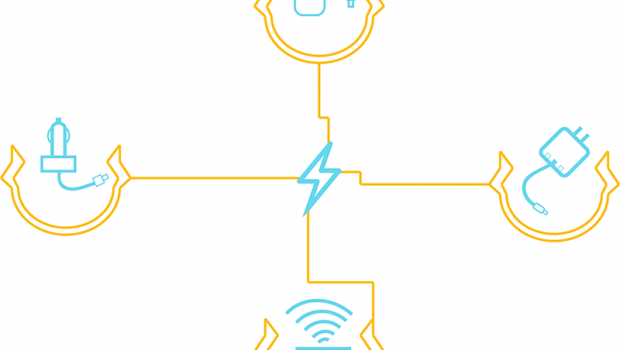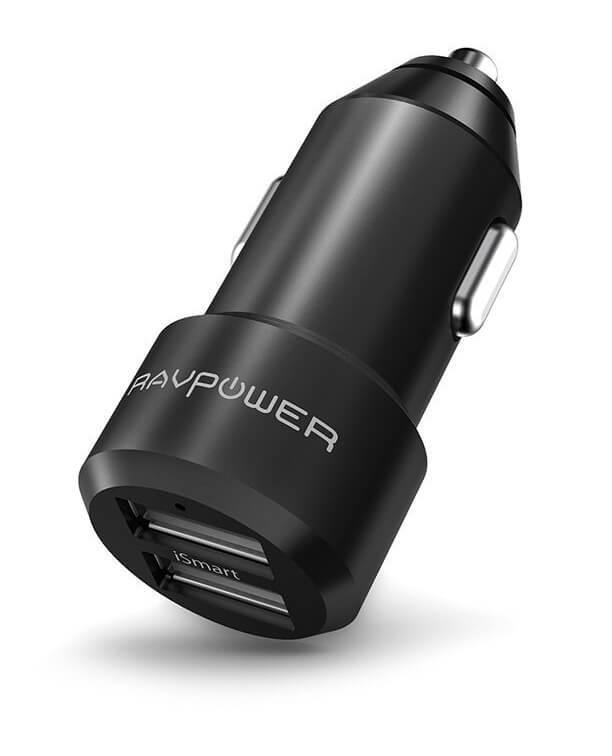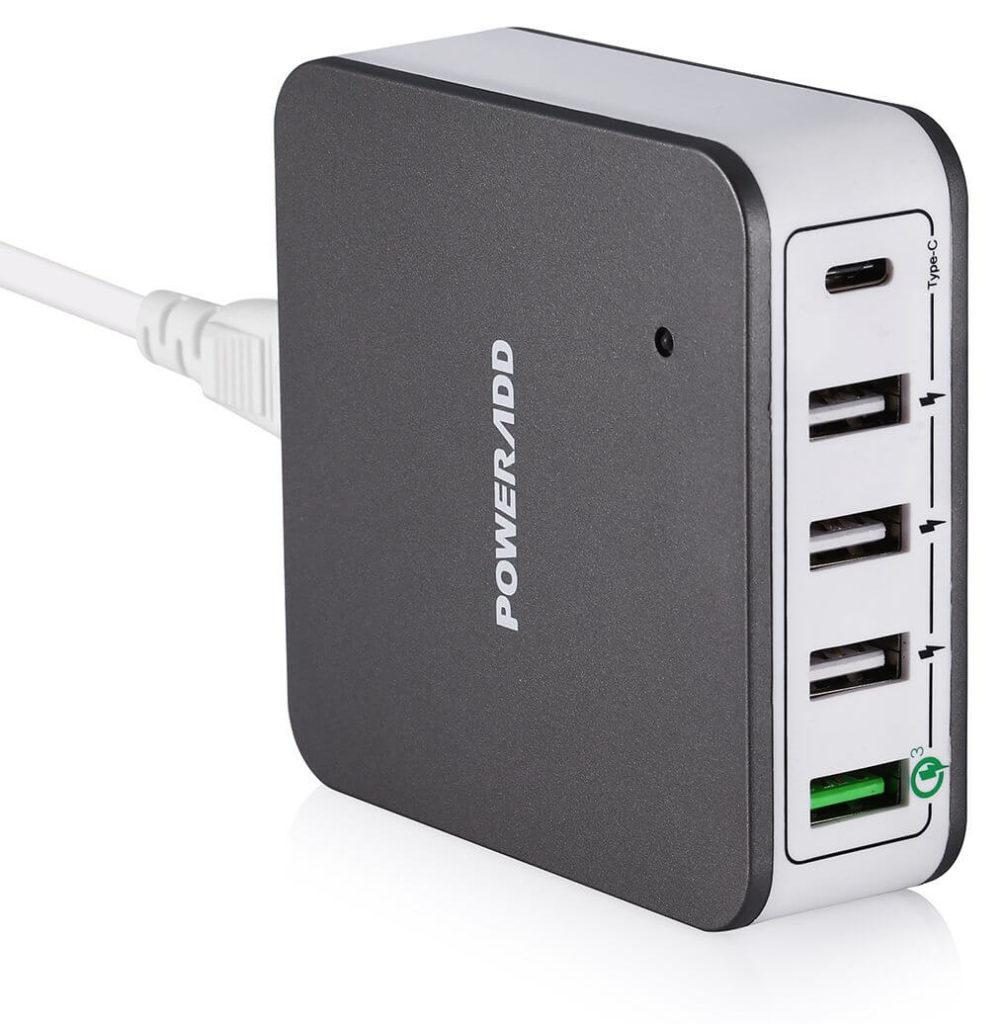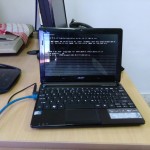The Best Charging Electronics that go Perfectly with Each Other
3 of the Best Power Banks to Own
Starting with the Lower Capacity Portable Charger: RAVPower Luster Power Bank
Power
Mini power banks aren’t exactly the most powerful of power banks because they don’t have very fast Output charging or Input charging. In this case, though, this RAVPower portable holds a lot of charging power.
Output Charging: 5V/2.4A
The Output charging, which is basically the charging that you’re using is really fast and this cannot be said about lots of other Mini power banks. This is because the Output charging is 5V/2.4A. That’s a Max standard charging speed, which means it’s the charging speed that comes right before Quick Charge.
You’ll be able to charge most smartphones at their max charging speeds, and you can even charge tablets at their max charging speeds of 2.4 Amps.
Input Charging: 5V/2.0A
Something that is not very common with power banks like these is their recharging speeds are not fast. This Luster portable charger goes against that since it can be recharged at 5V/2.0A and this can only be done if you’re using a 2 Amp wall charger. If that’s done, then it can be fully recharged in 2-3 hours.
The Power Capacity:
This RAVPower Luster power bank uses Panasonic batteries and that means it’s able to have better Output power capacity. Most power banks lose quite a lots of power capacity during charging and this is mainly because a conversion of energy is happening. When you couple the power of high-quality batteries that this portable charger uses along with its charging speed, you’ll only lose about 500mAh during charging.
As a result, you can charge most smartphones about 1 time.
Design
Portability:
It’s really portable and we mean really portable. It has a length of only 4 inches and a width/thickness of 0.9 inches. The Luster power bank is easily going to be able to fit into your pocket, and you can hold it while you’re using your smartphones because it’s lightweight at 2.6 ounces.
Going into the Intermediate Levels: Lumina 15,000mAh Power Bank
Power
Output Charging: Per Port: 5V/2.4A Max Output: 4.8A
When a power bank goes into the higher capacity ranges, the charging capabilities of it become more important and that why this Lumina power bank is able to Output 5V/2.4A out of each of its charging ports. In total, the power bank can Output 4.8 Amps all at once and that means each of the 2 ports can charge at their max charging speeds.
This kind of charging speed is very useful not only for charging smartphones very quickly but also being able to charge 2 iPads at their max charging speeds.
Input Charging: 5V/2.0A
Recharging is good with the Lumina being able to recharge at 5V/2.0A and by using a 2 Amp wall charger or higher you can get a full recharge within 6-7 hours.
Power Capacity:
Even though the power bank doesn’t use any special batteries like Panasonic or LG batteries, it still manages to give an approximate 12,000mAh Output power capacity. It’s with this power capacity that you’ll be able to charge many devices multiple amounts of times. This power capacity is perfect for charging smartphones as the power capacity can charge them many times over and best of all, if you’re charging smartphones with this power bank only, then it can very well last for a week long without needing a recharge.
Charging tablets is a very realistic possibility as you’ll be able to charge Mini tablets once to their full power capacity and still have some power left over. If you want to charge Full-Sized tablets to their full power then be prepared to use the entirety of the power capacity.
Design
Portability:
So it’s actually quite a large power bank and a heavy one at that. This can mostly be attributed to it being made of Aluminum Alloy. So it may be heavy, but you can still carry it and use. For the most part, though, you’re going to want to set it down and use it. The Lumina power bank has a length of 6.7 inches, a width of 4.1 inches, and a thickness of 0.6 inches. The weight is 1 pound. So it’s not the most portable and it’s mainly because the power bank has a great build quality to it.
Scraping the Sky with this High Capacity Power Bank: Anker PowerCore II 20000
Power
Output Charging: Per Port: 5V/3.0A Max Output: 6A
The 2nd PowerCore 20000 has got to be one of the best power banks on the market and this is due to the amazing charging power.
It has 3 Output charging ports, each of the charging ports is able to Output 5V/3.0A and that means that even though this power bank does not feature Quick Charge, Quick Charge and USB-C charging devices can still charge near their max charging speeds. Of course, standard charging devices can charge at their max charging speeds as well; it’s just really surprising that this power bank breaks from the typical max charging speed of 5V/2.4A and pushes it into the 3 Amp range.
Then there’s the max Output which is 6 Amps all at once. So if you’re charging 3 iPads at the same time, then each of them will be charging at 5V/2.0A and that’s a really good charging speed! This portable charger is an absolute beast from Anker and it’s one of the reasons why Anker is one of the best power bank brands on the market.
Input Charging: 5V/2.0A Per Micro-USB Input Port Overall: 4A
Just as the Output charging is amazing, so is the Input charging. When power banks go into higher power capacities charging times become longer and that can be a real problem. So Anker made 2 Micro-USB Input ports for this power bank and each of them can charge at 5V/2.0A, and if you’re using a 2 Amp wall charger with 2 ports, then the power bank can recharge at 4 Amps altogether. This can result in the portable charger being recharged within 6 hours or under!
We’re coming to a point where even higher capacity power banks are expected to recharge quickly and that is awesome.
Power Capacity:
One of the main aspects of most Anker power banks is that they use Panasonic Lithium Ion batteries and that leads them to get really good Output power capacities. Well, that’s not the case here and even so, the 2nd PowerCore 20000 is still able to pull off a 17,000mAh high power capacity.
It’s with this power capacity that makes the possibilities endless as you’ll be able to charge smartphones 6 times and beyond. This monster can cut right through tablets as well, with Mini tablets being able to charge all the way and still leaving the power bank with power left over. Full-Sized tablets can also charge to their full power and just leave a little power left too.
No matter what you plan on charging, we can confidently say that this charger is able to withstand any device and charge it to its max power.
Design
Portability:
Not exactly small or even the lightest portable charger, but the PowerCore 20000 is what it is because of its 20,000mAh power capacity and you won’t be getting anything much smaller than this with its kind of power capacity. With that said, it has a length of 6.2 inches, a width of 2.6, and a thickness of 1.1 inches. So it’s manageable in just a single hand but it’s the weight of 12 ounces that’s going to make you want to set it down.
Overall, from the 20,000mAh power bank market and above, things will only get larger and heavier. It’s one of the reasons why we picked this power bank too, it hits a perfect balance of power and portability without being too overbearing.
2 of the Best Wireless Chargers to Own
A Small but Powerful Device: Yootech Qi Wireless Charging Pad
Power
Input: 5V/1.5A | 5V/2.0A
Output: 5V/1.0A
Wireless charging still has quite a long way to go mostly because it’s simply not that good at providing fast charging speeds and you’re ultimately still using a charging cable to provide charging to your smartphones, it’s just that the charging cable isn’t going into your smartphone, it’s going into the wireless charger.
This Yootech wireless charger is quite powerful because it’s able to Output 5V/1.0A charging speed, in comparison to other wireless chargers only providing 500mA, which is just half an Amp. However, to make sure that you’re getting the fastest wireless charging with this wireless charger it’s best to use a 2 Amp wall charger or higher so there’s enough power being given to the wireless charger to function properly.
Design
It’s really small and that’s the main aspect that wireless chargers are looked at for because the smaller the wireless charger the better. In this case, though, it somewhat comes at a cost because the Yootech wireless charger only has a single coil that it charges with. This means that you’ll have to carefully place your Wireless charging compatible smartphones onto wireless charger in order for it to begin charging and keep charging.
Going a Bit Further on the Wireless Scale: RAVPower 3-Coil Wireless Charger
Power
Input: 5V/2.0A
Output: 5V/1.0A
Very similar to the Yootech wireless charger, this RAVPower wireless charger has to take a Input of 5V/2.0A and with that, the RAVPower wireless charger is able to Output a charging speed of 5V/1.0A, and once again that’s not exactly a fast charging speed in comparison to power banks and wall chargers, but this is mainly where wireless chargers are currently at.
Design
The main aspect that’s being worked on for wireless chargers is more of what they offer in terms of their experience. This RAVPower wireless charger also goes above normal wireless charging speed standards. Not only that, it uses 3 coils and that means that you can charge your smartphones at any orientation; both landscape and portrait, so you don’t have to worry about your smartphone stopping its charging.
3 of the Best Car Chargers to Own
Small but Still Powerful: RAVPower 4.8A Car Charger
Design
One of the most prominent things for a car charger is just how much it sticks out and just how low profile it is. Car chargers are meant to be as small and not noticeable at all. That’s definitely the case with this RAVPower 2 port charger because it just has a length of 2.3 inches and a width/thickness of 0.9 inches. With those 2 things, this RAVPower car charger is VERY low profile and won’t be getting in your way.
Best of all, it has Blue LED lights within the charging ports that make the car charger very easy to use during night time.
Power
Output: Per Port: 5V/2.4A Max Output: 4.8A
Car chargers aren’t expected to be on the same standard as other charging electronics and but in the modern day, they’re very much on the same standard that USB wall chargers and power banks are supposed to provide. This is especially true for this RAVPower car charger since both of its charging ports offer a Max standard charging speed of 5V/2.4A. Not only are the individual charging ports superb, the overall Output of 4.8A makes it so that each port can Output of 2.4A charging speed at the same time.
As a result, you can charge 2 iPads at their max charging speeds if you wanted to.
Special Tech that Is Very Powerful for Some: Anker PowerDrive+2
Design
Some car chargers are shaped rather oddly and car chargers are the one charging technology product where you can noticeably tell that there’s something different happening with it. In this case, the Anker PowerDrive+2 has a normal stem and then at the other end of the car charger is a block shape. So it’s still a small car charger, it’s just that you’re going to have a block that’s sticking out of your car’s V12 socket.
Not the lowest profile car charger but this is mostly because the powering from this PowerDrive+2 is really strong.
Power
Output: Quick Charge 3.0 Port: 3.6-6.5V/3.0A – 6.5-9V/2.0A – 9-12V/1.5A
Other Port with QC 2.0: 5V/2.4A – Quick Charge 2.0
The main feature for the PowerDrive+ 2 car charger is that it uses 2 very fastest charging technologies like Quick Charge 3.0 in one single port and the Quick Charge 2.0 AND PowerIQ charging in the other port at the same time. This means that you can charge 2 Quick Charge compatible devices at their max charging speeds at the same time. Not only that, you can also charge standard charging device at a fast rate with the port that features PowerIQ at 5V/2.4A.
The charging port that features Quick Charge 3.0 can only charge standard charging devices at 5V/2.0A; it’s still a fast charging speed, but this car charger is mainly meant for those that have Quick Charge compatible devices.
Lots of Ports with a Car Charger? Yes: Aukey 9.6A Car Charger
Design
There’s not many like it. 4 charging ports with a car charger. Many think that car chargers can’t possibly have this many charging ports because, well, you’re using it in the car. Here it is, though, this Aukey 4 Port car charger is a powerful beast that is unusual to look at but very awesome to use.
Of course, with something that has this many charging ports, this 4 port car charger isn’t going to be the lowest profile car charger and if you do plan on getting this or other 4 port car chargers, then be prepared for it to be sticking out of the Wall socket quite a bit.
Just How Much? It’s going to be out 2 inches from the socket.
Power
Output: Per Port: 5V/2.4A Max Output: 9.6A
However, are you buying this car charger in hopes that it’s going to be small? No. The reason that you’re going to want to purchase this car charger is because it’s powerful and how many devices it can charge at the same time.
So having 4 charging ports means that you can charge 4 devices at once. Not only is that amazing, but each of the charging ports is able to charge at Max standard charging speed of 5V/2.4A. Let’s go even further and tell you that the Max Output is capped at 9.6A. This means that you can potentially charge 4 iPads at the same time with them all charging at their max charging speeds.
Well, you may not even be charging tablets with this car charger but it’s just assurance that you’ll be able to charge multiple smartphones at the same time at or near their max charging speeds.
3 of the Best USB Wall Chargers to Own
Going Back to the Basics: Anker PowerPort 2
Power
Yeah, there are plenty of wall chargers out there that have many charging ports that offer special charging tech like USB-C Outputs and Quick Charge ports which we’ll be getting to in a moment. Then there are USB wall chargers like this PowerPort 2 that offer an optimum charging experience even just by having 2 charging ports.
Why is this wall charger so good? It’s because it’s been optimized with both of the charging ports offering 5V/2.4A charging speed. The max Output of 4.8A means that you’ll be receiving a Max Output from each of the ports at all times. The PowerPort 2 wall charger is the go-to kind of wall charger for everyone that’s looking for a wall charger to provide enough power to either charge their smartphones or tablets devices directly at a fast charging speed.
On the other hand, this wall charger is perfect to use with this Wireless chargers and to recharge power banks because it supplies lots of power.
Design
The use of foldable plug-pins means that the wall charger will be very compact and it’s perfect for traveling since it’s lightweight. One of the main things to look out for when you’re searching for a wall charger that’s small like this is to make sure that it doesn’t cover other Outlets whether it’s on a wall outlet or a power strip. In this case, the Powerport 2 does a perfect job at making itself compact enough that it doesn’t cover up any other outlets, so there are no compromises.
A Step up From the Rest: Poweradd 5-Port Wall Charger with USB-C and Quick Charge 3.0
Power
If you have the compatible type of devices, this Poweradd wall charger is able to provide an optimum level of charging. We say this because it really does, by having 3 Max standard charging ports, a USB-C port, and a Quick Charge 3.0 port, this USB wall charger is basically firing on all cylinders.
The 3 Standard charging ports:
For those that want to charge their Standard charging devices at their max charging speeds, the 3 white charging ports are perfect because each of them is able to Output 5V/2.4A amount of power.
The Quick Charge Port:
All the way at the bottom is where there’s the Quick Charge 3.0 port that is best used for those with either USB-C or Quick Charge compatible devices as you’ll be able to charge those kinds of devices at their max charging speeds.
The USB-C Port:
At the top is the USB-C port and you have to use a USB-C to USB-C charging cable to make use of this charging port and it’s meant for those that own USB-C compatible device. You can even charge a MacBook with this USB wall charger.
Last, but not least is the Max Output being 8 Amps. It’s not a limiting Max Output but you still have to be careful with the way that you use the wall charger because you don’t want to use so much power that you end up limiting the charging speeds of the Quick Charge or USB-C port.
Design
With a something that has 5 charging ports, of course, this wall charger makes use of a power cord. Without the power cord, the wall charger itself is just a square and it’s really portable if you plan on taking it with you for traveling purposes. The use of a power cord that is 5 feet long is very convenient as you can place it on a desk and have all of your charging devices right next to you.
Going Where No One has Gone Before: Anker PowerPort 10
Power
USB wall chargers like this Anker PowerPort 10 are not very common at all, mostly because many other charging electronic companies simply don’t find the need for people to use them. However, that’s a rather naive way of thinking because the ability to charge 10 devices at once isn’t entirely something that that a single person can do. Although, many people can have their single devices charging at the same time and that can result in 10 devices charging at the same time.
That’s where the Anker Powerport 10 comes in. It’s the ultimate charging hub.
Each of the charging ports is able to Output 5V/2.4A, the Max standard charging speed and even though it doesn’t feature Quick Charge it’ll still be able to charge most devices at their max charging speeds and that also goes for Quick Charge compatible devices. The Max Output of 12 Amps means that you can potentially charge 5 iPads at the same time at their max charging speed; ultimately, this means that if you’re charging only smartphones with this 10 port wall charger, you can potentially charge more than 5 at the same time with them all charging at their max charging speed.
There are very few limits with a wall charger like this and Anker has made sure of that, even when you’re maxing the wall charger out there is tons safety tech reinforcements that keep the charger from overheating as it has command over the Amp Current.
Design
With the use of 10 USB ports, this wall charger is not small nor is it light, and yet it’s still able to be portable. It’s about the size of a book and the Powerport 10 uses a 5-foot power cord. You can place the PowerPort 10 close to you or just place it in the middle of a living room in an easy to reach spot so the whole family can charge their devices at once. Or you can take it to the office and be a charging hero.
Detaching the power cord from the Powerport 10 makes the USB wall charger highly portable and you can place it into a bag, just know that this wall charger weighs at a heavy 1.8 pounds.
About the Author:
Usman Haq is the Founder and Writer for Charger Harbor. A website that covers many aspects of charging technology from Power banks to Wireless chargers and everything in between.


























